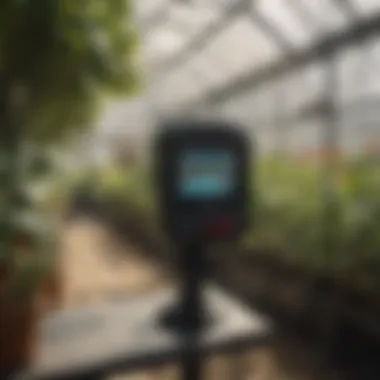Understanding Lumen Meters for Efficient Farming


Intro
Lumen meters are essential tools in modern agriculture. They provide valuable insights into light intensity, which is a critical factor in plant growth. Whether for greenhouse operations or open-field cultivation, understanding the light requirements of crops can lead to healthier plants and improved yields. This section will cover key concepts related to lumen meters, their operational principles, and the terminology associated with their use.
Key Concepts and Terminology
Definition of Terms
A lumen meter, often referred to as a light meter, measures the amount of light emitted from a source. It measures in lumens, giving farmers a direct understanding of light intensity. Key terms include:
- Lumen: A measure of the total quantity of visible light emitted by a source.
- Photosynthetically Active Radiation (PAR): This refers to the spectrum of light that plants use for photosynthesis, typically measured in micromoles per square meter per second.
- Light Intensity: The amount of light falling on a given area, important for assessing crop needs.
Overview of Relevant Practices
Using lumen meters is not just about taking measurements. Farmers can implement practices like regular monitoring of light conditions during different growth stages.
- Monitor daily: Regular monitoring helps adapt to changing environmental factors.
- Calibration: Ensuring the lumen meter is accurate is crucial for reliable data. This usually involves comparing readings with a known standard or reference.
Current Trends and Innovations
Latest Research and Developments
Recent studies focus on the role of light in plant health. Researchers are examining how specific wavelengths impact growth rates. Understanding this can help farmers choose the right lighting systems for their needs.
Emerging Technologies and Tools
New technologies enhance the capabilities of lumen meters. Wireless devices allow for remote monitoring, enabling farmers to track light conditions in real time. This data can be integrated with weather forecasts for better decision-making.
Practical Applications
Step-by-Step Guides
Implementing a lumen meter in agricultural practices involves several steps.
- Select the right meter: Choose a model that meets your specific needs.
- Calibrate the device: Follow the manufacturer’s instructions for calibration based on your environment.
- Conduct measurements: Regularly take and record measurements in various locations of your farm.
- Analyze data: Look for patterns in the data. Adjust planting or harvesting schedules based on light conditions.
Troubleshooting Common Issues
Farmers may encounter issues with lumen meters. Common problems include inaccurate readings or sudden changes in measurements. To troubleshoot:
- Recheck calibration to ensure accuracy.
- Inspect for obstructions or dirt on the sensor.
- Cross-reference readings with another meter if available.
"Accurate light measurement is key to optimizing crop management practices."
Understanding lumen meters and their applications enables farmers to maximize light efficiency and crop productivity. This guide serves as a foundation for integrating these tools into effective agricultural practices.
Preamble to Lumen Meters
Lumen meters serve a vital role in agricultural applications, where precise measurement of light is crucial for optimal plant growth. For farmers and agricultural enthusiasts, understanding how to utilize lumen meters can lead to significant improvements in crop management and yields. This section explores the definition of lumen meters, their importance in agronomy, and the historical context that shaped their development.
Definition and Importance
A lumen meter is a device used to measure the intensity of light. Light plays a pivotal role in photosynthesis, affecting plant health and growth. By measuring lumens, these devices provide farmers insights into light conditions in their growing environments. This is essential not just for indoor farming, but also for greenhouses, where managing light effectively can make the difference between a good harvest and a poor one.
The primary benefit of using a lumen meter is its ability to guide decisions related to plant placement and lighting strategies. For instance, knowing the lumens received in a particular area can help in arranging plants to maximize exposure. Additionally, these devices assist in determining the effectiveness of grow lights or natural sunlight in different farming setups. Without proper light measurement, farmers risk under or overexposing plants to light, directly impacting yield and quality.
Historical Context


The development of lumen meters is tied to advancements in light science. The concept of quantifying light goes back centuries, but formalized measurement began taking shape in the late 19th century with the emergence of photometry. Early light meters were primarily designed for photography, focusing on measuring ambient light conditions.
As agriculture evolved with technology in the 20th century, the need for precise light measurement in farming became evident. Innovations in sensor technology led to more specialized light measuring devices that cater to agricultural needs. Over time, lumen meters transitioned from bulky, analog devices to more sophisticated digital ones, improving accuracy and ease of use.
This historical development reflects the increasing recognition of light's role in agriculture. The adoption of lumen meters has evolved, adapting to new agricultural practices and technologies aimed at maximizing crop yields and sustaining healthy plant growth. These devices are now integral tools in both commercial and hobbyist agricultural practices.
Principles of Light Measurement
Light measurement is central to understanding plant growth, especially in controlled agricultural environments. Accurate light measurement influences choices made by farmers, such as selecting the right light sources and determining the optimal conditions for crop growth. Lumen meters play a crucial role in this domain.
Understanding Lumens
Lumens are the units that quantify the total amount of visible light emitted by a source. They reflect how bright a light source appears to the human eye. For agriculture, knowing the number of lumens produced by artificial lighting helps farmers provide adequate light for crops, especially in indoor settings.
The significance of lumens in agriculture lies in their ability to guide decisions about light placement and intensity. For example, fluorescent lights typically produce between 2,500 to 7,000 lumens per fixture, while LED lights can produce more with less power. This knowledge allows agricultural professionals to maximize energy efficiency while still meeting the light requirements for optimal plant growth. Understanding lumens helps to fine-tune lighting systems tailored for specific crop needs, improving overall productivity.
Lumen versus Lux
Lumen and lux are related but not interchangeable concepts. While lumens measure the total visible light emitted, lux measures how that light is distributed over a surface area. One lux equals one lumen per square meter. This distinction is particularly vital in agricultural settings where the aim is to determine the effectiveness of light at the plant level.
Knowing both the lumens produced and the lux levels reaching the plant surfaces allows for a more informed approach to lighting design. For example, if a greenhouse applies lighting that produces 10,000 lumens over a 50 square meter area, the lux level is 200 lux. This ensures that crops receive adequate light intensity.
Understanding the relationship between these two units empowers farmers to adjust lighting configurations. Proper lumens and lux readings can lead to better decisions regarding crop placement, light distance, and timing of exposure.
Accurate light measurement enables farmers to optimize their practices, potentially leading to healthier crops and higher yields.
In summary, understanding the principles of light measurement through lumens and lux is essential for achieving efficient agricultural practices. These concepts inform decisions that impact crop health and yield, laying a foundation for effective cultivation methodologies.
Mechanisms of Lumen Meters
Understanding the mechanisms of lumen meters is essential for agricultural professionals aiming to enhance their crop management practices. These devices play a critical role in measuring light intensity, which is a vital factor influencing plant growth and productivity. By grasping how different types of lumen meters operate, farmers can optimize their use of light in various agricultural settings, such as indoor farms and greenhouses.
Types of Lumen Meters
Lumen meters come in various forms, each designed to meet specific measurement needs. The three primary types include analog, digital, and integrated sensors.
Analog Lumen Meters
Analog lumen meters are among the simplest and most traditional forms of light measurement instruments. Their primary advantage lies in their ease of use. These devices typically feature a needle gauge that moves along a scale, indicating the lumen value. This makes them accessible for users who may not have technical expertise.
A key characteristic of analog lumen meters is their reliability in stable environments. They do not depend on battery power, which reduces the chance of malfunction during critical times. However, they can be less precise than contemporary digital options. The unique feature here is their straightforward visual reading, allowing quick assessments. Despite their simplicity, users must be careful when interpreting readings, as subjective bias may affect judgment.
Digital Lumen Meters
Digital lumen meters represent a significant advancement in light measurement technology. These devices provide precise, numerical readings that are easy to interpret. They often come equipped with features like data storage, enabling users to track light intensity over time. The convenience of these meters often makes them a popular choice among modern agriculturalists.
The key characteristic of digital lumen meters is their high accuracy, which is crucial for scientific applications in agriculture. Unique features include backlit displays for easy reading and the ability to connect to computers for data analysis. However, those reliant on batteries must be diligent about power levels, as battery failure can disrupt important measurements.
Integrated Sensors
Integrated sensors offer a more advanced solution for light measurement. These devices combine various functionalities into a single unit, often integrating with smart farming practices. Their contribution to this field lies in their ability to provide real-time data analytics, which can significantly aid decision-making processes.
The key characteristic of integrated sensors is their multifunctionality. They can measure not only light intensity but also other environmental factors such as temperature, humidity, and soil moisture. This capability makes them a beneficial choice for those looking to enhance their agricultural practices holistically. Nevertheless, users may face a steeper learning curve due to the complexity of these devices compared to simpler analog options.
Calibration Techniques
Calibration is a crucial aspect of utilizing lumen meters effectively. Proper calibration ensures the accuracy and reliability of measurements. It involves comparing the readings of the meter to a known standard to adjust and correct any discrepancies. Each type of lumen meter may have different calibration requirements, so understanding these is essential for farmers aiming to implement effective measurement protocols.
Applications in Agriculture


In the context of agriculture, lumen meters serve a crucial role by providing precise measurements of light intensity. These devices help farmers understand the lighting conditions necessary for optimal plant growth. The applications of lumen meters range from traditional farming practices to modern, high-tech indoor farming facilities. The importance of precise light measurement cannot be overstated, as it directly impacts crop vitality and yield.
Role in Indoor Farming
Indoor farming relies heavily on artificial lighting systems to ensure plants receive sufficient light. Lumen meters play a vital role here, allowing farmers to calibrate the intensity of their lights. This is particularly essential when using LED grow lights, which have specific wavelengths beneficial for different plant stages. Understanding the data provided by lumen meters can help achieve an ideal light spectrum and intensity, fostering consistent plant growth. By fine-tuning light levels, growers can maximize photosynthetic efficiency, ultimately leading to higher yields and healthier crops.
Utilization in Greenhouses
Greenhouses are another setting where lumen meters are invaluable. Inside these controlled environments, varying light levels from both natural sunlight and supplemental lighting must be monitored. Lumen meters provide real-time data that can inform decisions on adjusting shades, vents, or additional lighting. Efficient use of light not only enhances plant growth but can also reduce energy costs. When integrated into greenhouse management systems, these devices can automate light adjustments, optimizing conditions based on time of day and season. This contributes to sustainability and better resource management.
Impact on Crop Yield Assessment
Assessing the impact of lighting on crop yield is a key factor in agricultural success. Lumen meters enable farmers to collect reliable data regarding light exposure. By correlating light levels with crop yield, farmers can make informed decisions regarding crop rotation and planting schedules. Studies show that specific light intensities lead to better quality crops, influencing market value. Additionally, gathered data can assist in predicting outcomes, allowing farmers to adapt their strategies in real-time for improved productivity.
"Understanding light conditions is fundamental to successful agriculture. Lumen meters provide the insight needed for making informed cropping decisions."
Through these applications, lumen meters enhance the efficiency and effectiveness of agricultural practices. Farmers who embrace these tools can expect to see better crop management and optimal production in varied farming environments.
Integrating Lumen Meters into Agricultural Practices
The integration of lumen meters into agricultural practices is essential for achieving optimal plant growth and productivity. Understanding how to utilize these devices effectively can lead to better light management, which is crucial in various farming environments, including greenhouses and indoor farms. As light is a pivotal factor in photosynthesis, farmers must ensure that plants receive the appropriate light intensity. Using lumen meters can significantly enhance crop production by providing precise measurements of light levels needed for different growth stages.
Best Practices for Measurement
To ensure accurate and reliable measurements with lumen meters, it is vital to follow certain best practices:
- Positioning the Sensor: Place the sensor at the plant canopy level. This strategy captures the light intensity that reaches the leaves, providing a true representation of the light environment.
- Consistent Timing: Take measurements at the same time every day to account for variations in natural light due to atmospheric conditions and time of day.
- Data Logging: Utilize data logging features if available. Continuously recording light levels over time allows for better trend analysis and adjustments in light management strategies.
- Calibration Checks: Regularly check the calibration of the lumen meter, following manufacturer recommendations to maintain accuracy.
- Environmental Factors: Consider environmental influences such as shadows, reflective surfaces, and plant spacing while taking measurements.
By adhering to these practices, farmers can obtain more reliable data, enabling them to make informed decisions regarding lighting needs in their agricultural systems.
Setting Up Measurement Protocols
Establishing measurement protocols is an integral aspect of efficiently using lumen meters:
- Define Objectives: Clearly outline what you aim to achieve with the measurements. This could involve monitoring light levels for specific crops over time or assessing the impact of lighting changes on growth rates.
- Frequency of Measurements: Decide how often to take measurements. It can be daily, weekly, or based on growth phases, depending on the agricultural setting.
- Documentation: Maintain a detailed log of all readings. Record the date, time, location, and conditions of each measurement. This documentation will be useful when analyzing data trends and making adjustments.
- Review and Adjust: Regularly review the collected data to adapt your light management practices. If certain measurements indicate insufficient light, adjustments in supplemental lighting or greenhouse arrangements may be necessary.
- Engagement with Professionals: Engage with agricultural specialists or local extension services for insights into optimizing lighting strategies based on measurement results. Their guidance can assist in aligning practices with current scientific understanding.
Following these steps can create a systematic approach to utilizing lumen meters effectively in agricultural settings. This methodical integration will lead to improved awareness and optimization of light management strategies.
Case Studies and Examples
Successful Implementation in Crop Management
Implementing lumen meters effectively can transform crop management strategies. A notable example can be seen in a greenhouse operation that focused on optimizing light for tomato plants. The cultivation team utilized digital lumen meters to measure light intensity at various growth stages. They discovered that under specific light conditions, the plants showed a 20% increase in growth compared to traditional methods without precise measurement.
This technology allowed them to adjust their artificial lighting systems according to the readings from the lumen meters. The adjustments resulted in a more consistent light supply, ultimately leading to higher yields and better quality produce. Furthermore, the team documented these measurements, which helped in creating a tailored light recipe for different plant varieties.
The success of this approach illustrates how lumen meters inform decisions in real-time, enhancing not just the productivity but also the economic viability of the operation. Through diligent monitoring and adjustment based on accurate readings, farmers can significantly mitigate risks associated with inadequate lighting. This case serves as a strong reminder of how data-driven methods can lead to strategic advancements in agricultural practices.
Lessons Learned from Failures
While there are successes, there are also important lessons to learn from failures related to lumen meter usage. For instance, a greenhouse that attempted to enhance cucumber yield faced challenges due to poor calibration of their analog lumen meters. They had initially relied on suggested settings from the manufacturer without local context. This oversight led to incorrect light intensity readings, misguiding their growing techniques.
Consequently, the cucumbers did not thrive, resulting in an overall yield reduction of up to 30%. The situation highlighted the need for ongoing calibration and local adjustment rather than blind adherence to generic recommendations.
Farmers learned that different environmental variables, such as altitude and geographical location, significantly affect light conditions. Thus, using case studies that reveal both successes and failures, it becomes clear that careful attention to calibration and local application matters greatly.
Such examples emphasize a critical consideration: the importance of tailored practices. Each agricultural setting could benefit from adjustments based on its unique conditions, ensuring that systems are not just efficient but also effective.


"The difference between success and failure often lies in the details of measurement and application."
Investigating these instances, both triumphs and mistakes, grants the agricultural community invaluable insights for future practices involving lumen meters. Keeping these lessons in mind will ultimately lead to a more informed approach to the use of light measurement technology.
Challenges in Using Lumen Meters
The incorporation of lumen meters into agricultural practices can significantly enhance light management for better crop growth. However, assessing the challenges associated with these devices is crucial for agricultural professionals. Understanding both practical and financial obstacles aids in strategic planning and resource allocation.
Technical Limitations
Lumen meters are powerful tools, but their technical shortcomings can hinder effective usage. There are multiple dimensions to consider here:
- Sensitivity to Light Conditions: Lumen meters often require specific ambient lighting conditions to function optimally. Under extreme sun or low light, readings may become unreliable. This limitation could lead to misguided decisions if not managed properly.
- Calibration Difficulties: Calibration of lumen meters is not always straightforward and usually requires precision. Inaccurate calibration can skew results, making it vital to regularly check and adjust the settings. Failure to do so poses risks in judgement of light intensity.
- Range of Measurements: Different crops might have varying light requirements. Not all lumen meters cover an adequate range for all agricultural scenarios. Therefore, selecting the appropriate meter is critical. Some models may not capture the lower light levels that specific plants need.
- Durability Issues: Agricultural settings can be harsh. Dust, moisture, and fluctuating temperatures affect the lifespan and performance of lumen meters. A robust design is essential for these devices to withstand field conditions."
Economic Factors
The financial implications of utilizing lumen meters in farming practices can't be overlooked. Here are key considerations:
- Initial Investment: Quality lumen meters can be expensive. For small-scale farmers, the upfront cost may deter them from purchasing. Analyzing whether the benefits outweigh the investment is vital.
- Maintenance Costs: Regular maintenance is essential for accurate readings. This adds to the overall cost of ownership. Farmers need to allocate budget for periodic servicing, calibration, and replacement.
- Training and Expertise: Staff training is another economic factor. Effective use of lumen meters often requires an understanding of light impact on crops. Farmers might need to invest time and resources into training personnel, adding to operational costs.
- Return on Investment: Calculating an accurate ROI on light management through lumen meters is complex. While these tools can lead to better crop yields, the time frame for seeing a financial return varies significantly.
"Understanding the potential challenges of using lumen meters can ensure that farms reap the benefits of these tools effectively."
Future Trends in Light Measurement Technology
The future of light measurement technology is vital in advancing agricultural productivity and sustainability. As agriculture faces various challenges, including climate change and the need for efficient resource use, innovations in light measurement tools can offer solutions. The incorporation of more sophisticated light measurement devices can help farmers achieve better crop yields, optimize energy use, and contribute to sustainable farming practices.
Advancements in Sensor Technology
Recent years have seen significant improvements in sensor technology. These advancements have resulted in more accurate and sensitive lumen meters. Modern sensors can measure light intensity across a broader spectrum, providing detailed insights into light conditions. This information allows farmers to manage lighting in controlled environments effectively.
- Enhanced accuracy: New sensor designs reduce measurement error.
- Multispectral sensors: These can measure a range of wavelengths, giving a complete picture of light conditions.
- Real-time data: Continuous monitoring provides immediate feedback on changing light conditions, allowing rapid adjustments in agricultural practices.
Such innovations can directly influence plant growth cycles and overall agricultural output.
Integration with IoT Solutions
The integration of Internet of Things (IoT) technology with lumen meters presents exciting possibilities. IoT solutions can enhance the data collection and analysis processes. By connecting lumen meters to a network, farmers can monitor light conditions remotely and automate responses.
Key benefits include:
- Remote monitoring: Access real-time data from anywhere, improving operational efficiency.
- Automated adjustments: Systems can be set to alter artificial lighting based on sensor readings, optimizing energy use.
- Data sharing: Aggregated data can help farmers understand broader trends in light intensity, leading to more informed decisions.
The combination of advanced sensor technology and IoT can lead to a transformation in how light is managed in agriculture. Farmers will not only benefit from increased efficiency but also from the ability to make data-driven decisions that enhance crop performance and sustainability.
"Investing in advanced light measurement technologies is not just about keeping up with trends; it's about redefining efficiency in agriculture."
Overall, these future trends point to a more data-informed approach to agriculture, where light management becomes a key factor in achieving agricultural success.
End
The conclusion forms a critical synthesis of the entire discussion surrounding lumen meters in agricultural contexts. Emphasizing their significance, this section encapsulates the essential components covered throughout the article. Lumen meters are not merely tools; they embody a strategic approach to crop management in modern agriculture. Their ability to measure light intensity directly correlates with the health and productivity of plants. Understanding how to utilize these meters effectively can lead to enhanced crop yields and sustainability in farming practices.
Summary of Key Insights
Several key insights have emerged from the exploration of lumen meters:
- Light Measurement and Crop Health: The relationship between light and plant growth is undeniable. High-quality measurements of light facilitate better understanding of how plants respond and adapt to varying light conditions.
- Practical Applications: Lumen meters cater to a variety of settings, from indoor farms to traditional fields. The versatility in their applications underscores their importance in the agricultural sector.
- Integration and Calibration: Effective calibration techniques ensure the accuracy of measurements, allowing farmers to make informed decisions. Adopting best practices for using lumen meters enhances data reliability.
- Future Trends: As technology progresses, sensors are becoming more advanced. The integration of these devices with IoT solutions promises to streamline data collection and analysis, making farming even more precise.
By synthesizing these insights, agricultural professionals can appreciate the multifaceted role lumen meters play in shaping efficient farming practices.
Final Thoughts on Lumen Meters in Agriculture
The future of agriculture is heavily influenced by technological advancements. Lumen meters represent a crucial intersection of technology and agronomy. Embracing such tools is essential for farmers who aim to optimize crop production.
Investing time to understand lumen meters and their applications can pay significant dividends. Farmers who adapt these practices will likely see improvements in crop yields and overall operational efficiency. This article aims to create awareness and knowledge among agricultural practitioners about the importance of light measurement in crop management.







